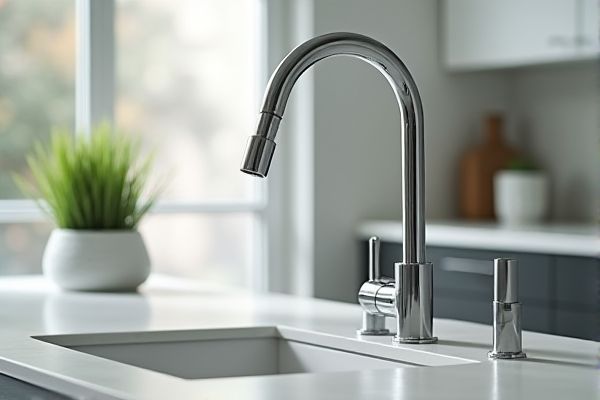
Touchless faucets offer enhanced hygiene and water efficiency by using motion sensors to activate water flow, reducing the spread of germs and conserving resources compared to manual faucets that require physical contact. Discover how choosing the right faucet can improve Your kitchen or bathroom experience by reading the rest of the article.
Table of Comparison
| Feature | Touchless Faucet | Manual Faucet |
|---|---|---|
| Operation | Sensor-activated, hands-free | Manual turn or lever control |
| Hygiene | Reduces germs and cross-contamination | Direct contact, higher germ risk |
| Water Efficiency | Automatic shutoff reduces water waste | Depends on user behavior |
| Installation | Requires power source (battery or electric) | Simple, no power needed |
| Maintenance | Sensor maintenance and battery replacement | Minimal, occasional cleaning |
| Cost | Higher initial and maintenance cost | Lower upfront and maintenance cost |
| Suitability | Ideal for public restrooms, healthcare | Best for residential and low-usage areas |
Introduction to Touchless and Manual Faucets
Touchless faucets utilize infrared sensors to detect hand movement, enabling water flow without physical contact, promoting hygiene and reducing the spread of germs. Manual faucets require users to turn handles or knobs to control water flow and temperature, offering straightforward operation but increasing contact points. The contrast between these faucet types highlights advancements in plumbing technology aimed at enhancing convenience and sanitation.
Key Features of Touchless Faucets
Touchless faucets feature motion sensors that detect hand movement, enabling water flow without physical contact, which enhances hygiene and reduces germ transmission. These faucets often include adjustable sensor ranges, temperature control settings, and automatic shut-off mechanisms to conserve water and improve user convenience. Your kitchen or bathroom benefits from the seamless operation and increased sanitation provided by these advanced, hands-free fixtures.
Key Features of Manual Faucets
Manual faucets feature a simple mechanism requiring physical handle operation to control water flow and temperature, providing a direct, tactile experience. They offer reliable functionality with minimal technology dependency, often resulting in easier maintenance compared to touchless models. Your choice may depend on the preference for traditional control and cost-effectiveness in installation and repairs.
Hygiene and Sanitation Comparison
Touchless faucets significantly reduce the spread of germs by eliminating the need to touch handles, making them ideal for maintaining high hygiene standards in public and healthcare settings. Manual faucets require direct contact, which can transfer bacteria and viruses between users, increasing the risk of contamination. Advanced infrared sensor technology in touchless faucets enhances sanitation by ensuring water flows only when hands are detected, minimizing unnecessary exposure to pathogens.
Water Efficiency and Conservation
Touchless faucets use infrared sensors to detect hand movement, allowing water to flow only when needed, significantly reducing water wastage compared to manual faucets that rely on continuous flow until manually turned off. Studies indicate that touchless faucets can reduce water consumption by up to 30%, contributing to effective water conservation efforts in residential and commercial settings. Incorporating touchless technology helps in minimizing runoff and promotes sustainable water use practices.
Ease of Use and Accessibility
Touchless faucets offer superior ease of use by eliminating the need to turn handles, making them highly accessible for individuals with limited mobility or dexterity. Manual faucets require physical effort to operate, which may pose challenges for users with arthritis or disabilities. You benefit from touchless technology's hygienic, hands-free operation that enhances convenience and accessibility in any setting.
Installation Process and Requirements
Touchless faucets require a power source, such as batteries or an electrical connection, and often involve more complex installation steps including sensor calibration. Manual faucets typically have a straightforward installation, involving direct connection to water supply lines without the need for electrical components. Proper wall clearance and suitable sink mounting holes are essential for both types, but touchless models demand additional considerations for sensor placement and wiring access.
Maintenance and Durability
Touchless faucets typically require less frequent cleaning since their hands-free operation reduces water spots and grime buildup, while their electronic sensors and batteries may need periodic replacement, affecting maintenance. Manual faucets have simpler mechanisms, often resulting in more straightforward repairs and longer mechanical durability without reliance on electronics. Choosing your faucet depends on whether you prioritize minimal upkeep with occasional sensor servicing or the robust, low-tech endurance of manual models.
Cost Analysis: Upfront and Long-Term
Touchless faucets typically have higher upfront costs, ranging from $150 to $400, compared to manual faucets which average $50 to $150, but they can reduce water waste and energy bills over time due to automated shutoff features. Long-term maintenance of touchless faucets may incur higher expenses owing to sensor repairs and battery replacements, whereas manual faucets generally require less costly maintenance but may lead to higher water usage. Evaluating the total cost of ownership involves balancing initial investment against potential savings in water and energy consumption for touchless models.
Choosing the Right Faucet for Your Needs
Touchless faucets offer enhanced hygiene and water efficiency by using motion sensors to reduce contact and waste, making them ideal for busy kitchens or bathrooms. Manual faucets provide greater control over water temperature and flow, often preferred for tasks requiring precision or in settings where sensor technology may be inconvenient. Evaluate your daily water use, hygiene priorities, and budget to determine whether a touchless or manual faucet best suits your lifestyle and needs.
 homyna.com
homyna.com